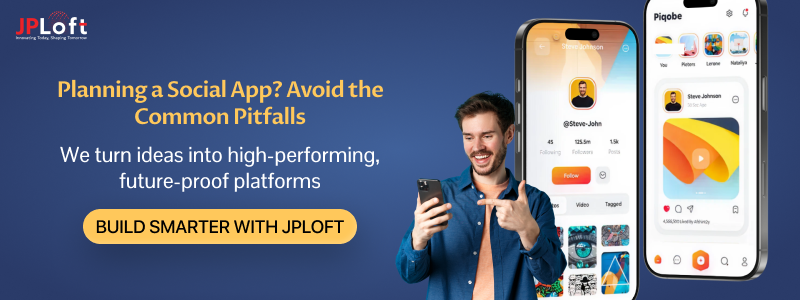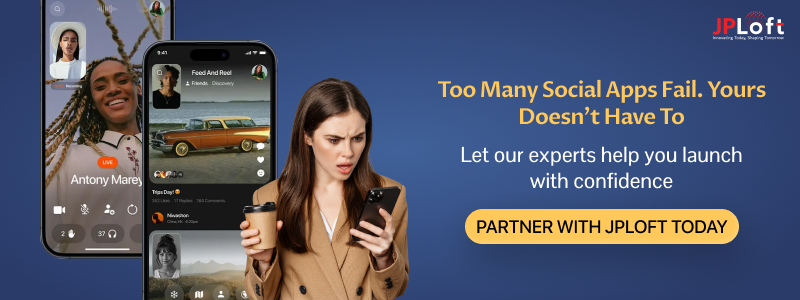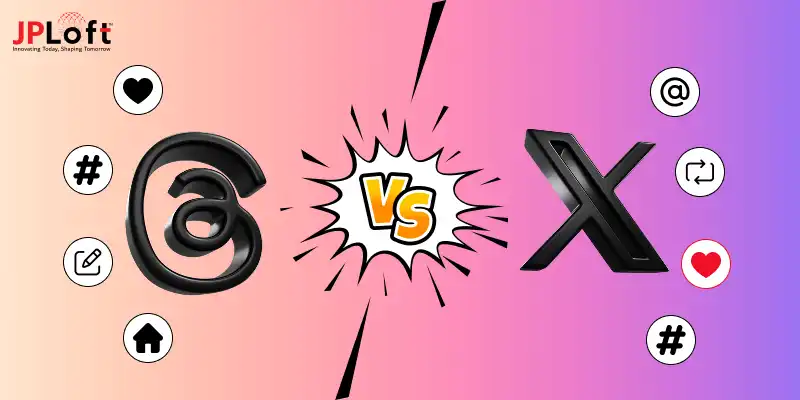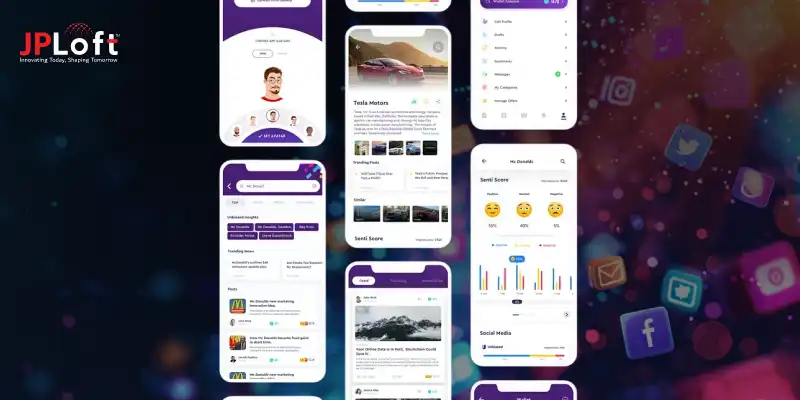So, you’ve got a brilliant idea for the next big social media app. You’ve seen the success of platforms like Instagram, Snapchat, and TikTok—and you’re convinced there’s still room to disrupt the space. But here’s the hard truth: most social media apps fail within the first 12 to 18 months.
Why do social media startup apps fail, even when the ideas seem great?
It’s not because the ideas are always bad. In fact, many failed social media platforms started with incredible concepts and talented teams. The problem? Execution, timing, scalability, monetization, and a long list of avoidable pitfalls.
In 2025, launching a social app isn’t just about building something “cool”. It’s about building something strategic, secure, user-focused, and adaptable—because the digital landscape is evolving faster than ever.
This blog dives deep into the real reasons why social media apps fail—from poor product-market fit to feature overload, broken monetization models, security missteps, and more. If you’re a startup founder, investor, or product lead working in this space, this is the blog you need to bookmark.
Let’s unpack the lessons learnt from social media startup failures—so your app doesn’t become one of them.
Social Media App Market Stats and Growth Insights (2025)
Let’s start with the big picture.
Social media is no longer just a digital playground—it’s a multi‑billion-dollar global industry. According to Kepios via DataReportal, there were 5.31 billion social media users worldwide as of April 2025—about 64.7% of the global population. Similarly, DemandSage places the figure at 5.24 billion, or 63.9% of the world’s population in 2025. That’s nearly two-thirds of the planet actively engaging on social platforms.
Sounds like an endless opportunity, right? Well, here’s where it gets tricky.
Despite these staggering numbers, launching a successful platform with competitive social media app features remains one of the hardest product challenges today. According to LLC.org, 90% of startups fail—with 10% failing within the first year and 70% folding between years 2 and 5. Exploding Topics echoes the same: only around 10% survive long-term.
There’s also intense platform fatigue setting in. Users don’t want another generic feed-based app—they crave personalization, privacy, and unique ways to connect. If your app can’t deliver that—or evolve with shifting behavior and expectations—it’s likely to fade out fast.
And let’s not forget the competition. If your product doesn’t offer meaningful differentiation compared to existing Discord alternatives or Snapchat alternatives, you’ll be buried before you even begin.
Bottom line? The market is huge, but unforgiving. To survive, your app must be smarter, more useful, and relentlessly user-focused from day one.
Top Reasons Why Social Media Apps Fail (With Real Startup Stats)
If you're wondering how social media apps fail despite massive user demand—you’re not alone. The truth is, building a social app is the easy part. Sustaining engagement, scaling smartly, and monetizing efficiently? That’s where most stumble.
Let’s break down the top reasons why social media apps fail, backed by real-world data, product strategy gaps, and user behavior patterns:
1. No Product-Market Fit
You might have a unique idea—but is it solving a real problem? According to CB Insights, 35% of startups fail because there's no market demand for what they’re offering. This is especially true in social media, where users are already overwhelmed with options. Apps that lack a clear use case or niche often vanish before even gaining traction.
2. Weak User Retention and Engagement
A huge launch day doesn’t guarantee long-term traction. Most social apps fail to maintain an acceptable DAU/MAU (Daily Active Users / Monthly Active Users) ratio. Anything under 20–25% indicates that users sign up but don’t stick around.
Without sticky features or emotional investment, people forget the app exists.
3. Feature Overload & Confusing UX
Many social startups fall into the trap of cramming in every trending feature—feeds, filters, chats, lives, stories, AI bots, and more. The result? A bloated, confusing, and unfocused product. Instead of doing one thing exceptionally well, these apps end up doing many things poorly—turning users off.
This is where poor planning around social media app development cost and prioritization can lead to disaster.
4. Lack of Monetization Model
Startups often delay thinking about money, assuming that revenue will follow if they build something “cool.” But burning investor capital without a monetization strategy is risky. Whether it’s ads, subscriptions, creator tools, or data licensing, you must define your monetization strategy early, before the investor runway runs out.
Startups that fail to do this often shut down due to runway issues.
5. No Clear Differentiation
What makes your app different from Instagram, Reddit, or Snapchat? If you can’t answer that in one sentence, your product is in trouble. Too many apps try to compete directly with giants instead of carving out a micro-niche or solving an underserved problem.
In a sea of the best social media apps, only those with a sharp identity survive.
6. Poor Community Management
A great platform means nothing without an active, well-managed community. Yet many startups underinvest in moderation, content guidelines, and creator engagement. As a result, toxicity, spam, or silence takes over.
Great community-building is often the difference between a downloaded app and a daily habit.
7. Technical Debt & Lack of Scalability
Your app might run well for 500 users—but what about 50,000? Apps that aren’t built for scale often crash under the weight of early success. Add to that issues like long load times, app crashes, or privacy vulnerabilities, and you lose user trust fast.
Failing to prioritize scalable backend architecture and security early on is a silent killer.
8. Poor Onboarding and First Impressions
You get one shot to impress a user—and it usually lasts less than 15 seconds. Apps that don’t clearly convey their value proposition during onboarding lose users before the journey even starts.
Effective onboarding should:
-
Be quick, clean, and intuitive
-
Demonstrate value upfront
-
Encourage immediate interaction
This is where how to design a social media app comes into play—and it matters more than most founders think.
9. Chasing Trends Without Vision
FOMO kills focus. Many social apps launch around a trend (e.g., “the Clubhouse of X”) but fail to evolve. When the hype dies, they’re left without a foundation. Innovation is key—but only if it aligns with long-term product vision and user needs.
Trendy without purpose = short shelf life.
10. Ignoring Competitive Research
Too many apps launch without doing thorough competitor audits. If you don’t understand what social media app development trends are shaping user expectations—or how your rivals failed—you’re bound to repeat their mistakes.
Competitor blind spots lead to wasted development cycles, mispositioned features, and avoidable failure.
This is one of the biggest reasons behind social media startup failure that founders overlook: underestimating the competitive landscape.
There’s no sugarcoating it—the bar is high, and the margin for error is razor-thin. But if you learn from these pitfalls and approach your app with clarity, vision, and adaptability, you’ll already be ahead of 90% of the crowd.
Failed Social Media Apps: Real Case Studies and What Went Wrong
The best way to understand why social media startup apps fail? Study the ones that already did.
Even well-funded, hyped, and innovative platforms have vanished from our home screens—because having a great idea isn’t enough.
Let’s dive into a few notable case studies of failed social media apps and what lessons they left behind.
► Case Study 1: Peach
Launch Year: 2016
What Was It? A quirky, semi-private microblogging app from a Vine co-creator. Peach lets users post updates using “magic words” (short commands like :song or :gif) and connect with friends in a playful way.
Why It Failed:
-
Lack of longevity and retention strategy
-
No clear monetization model
-
Rapid novelty burnout
-
Poor scalability of features for long-term use
Lesson: Quirk and novelty alone can’t build habit-forming behavior. Without a user loop or content ecosystem, excitement fades fast.
► Case Study 2: Google+
Launch Year: 2011
What Was It? Google's ambitious attempt to rival Facebook by combining search, Gmail, and social media in one platform.
Why It Failed:
-
Forced integration across Google services led to user frustration
-
Confusing user experience (Circles, Hangouts, Streams—too many layers)
-
Security issues and privacy concerns
-
Low engagement outside tech communities
Lesson: Even tech giants can fail without strong community alignment. Users don’t want a platform forced on them—they want one they choose.
► Case Study 3: Yik Yak
Launch Year: 2013
What Was It? An anonymous, location-based social app popular on college campuses. Users could post short messages visible within a 5-mile radius.
Why It Failed:
-
Rampant abuse and cyberbullying
-
Major moderation and trust issues
-
Lack of monetization and growth scalability
Lesson: Anonymity without moderation is a recipe for disaster. Especially in Gen Z-focused apps, community safety must be part of the tech stack from Day 1.
► Case Study 4: Clubhouse (rapid rise, uncertain future)
Launch Year: 2020
What Was It? The invite-only audio chat app that exploded during the pandemic as a drop-in podcast-style community platform.
Current Struggles:
-
Massive drop in active users post-pandemic
-
High churn rate
-
Failure to pivot or expand beyond niche use cases
-
Poor creator retention and monetization
Lesson: Virality is not longevity. Without evolving features and a broader roadmap, even viral platforms risk becoming Skype alternatives rather than category leaders.
► Case Study 5: Vero – True Social
Launch Year: 2015 (brief viral spike in 2018)
What Was It? A “no ads, chronological feed, privacy-first” alternative to Instagram that gained rapid popularity during user frustration with algorithm changes on mainstream platforms.
Why It Failed (or stagnated):
-
App performance issues during peak growth
-
Poor user experience and bugs
-
Weak community-building efforts
-
Failed to maintain momentum after the initial spike
-
Controversies around founder background hurt brand trust
Lesson: Even if you’re solving real user pain (algorithm fatigue, privacy), execution and trust are everything. Users expect a polished product and a brand they feel safe with—especially when you claim to be the “ethical alternative.”
These stories prove one thing: even the most promising ideas can fail if they aren’t user-centric, adaptive, and execution-ready.
In the next section, we’ll walk through actionable practices you can follow to avoid these exact mistakes.
How to Avoid Social Media App Failure: 10 Mistakes to Skip
You’ve seen why social media startups fail?. Now let’s flip the script. What can founders, product managers, and tech teams do differently to avoid becoming another social media startup failure?
Here are proven practices to build smarter, more resilient social platforms that don’t just launch — they scale, engage, and thrive.
1. Build Around a Clear, Unique Value Proposition
Start by answering: Why would users choose your app over what they already use?
Instead of cloning giants like Instagram or TikTok, focus on niche audiences, underserved needs, or new engagement formats.
Define a crystal-clear positioning statement, and test it early before scaling. Learn from the cost to develop an app like MeWe, which succeeded in some niches by staying community-first.
2. Prioritize Retention Before Growth
Forget about vanity metrics like downloads — retention is everything. Use metrics like:
-
Day 1, 7, 30 retention
-
DAU/MAU ratio
-
Time spent per session
Introduce habit-forming features like streaks, personalized feeds, or creator-based communities. Use smart push notifications—not spammy ones—to re-engage users.
3. Keep the MVP Tight & Focused
Avoid launching with every feature you can think of. Instead, focus on 1–2 features that solve a clear problem or spark a unique kind of interaction.
Use feedback loops from early adopters to shape what’s next.
A lean MVP reduces risk and helps validate faster—especially when resources and timelines are tight in early-stage product builds.
4. Make Community Health a Core Metric
Toxicity, spam, and harassment can destroy your platform from the inside out. Build:
-
Content moderation tools from Day 1
-
Transparent community guidelines
-
Empowered moderators and AI-powered filters
Apps like Reddit, Discord, and Twitch grew because they invested in safe, scalable ecosystems, not just cool features.
5. Don’t Delay Monetization Strategy
Even if your initial goal isn’t revenue, have a monetization roadmap ready. Consider:
-
Subscription models (ad-free, premium features)
-
Creator tools (tipping, merch, monetized content)
-
Brand partnerships or niche ad ecosystems
Modern users are used to paying for quality—especially when it supports privacy and creators. Explore revenue paths early—subscriptions, creator tools, or brand partnerships—and align them with your user expectations from the start.
6. Use Feedback as a Product Compass
No roadmap survives first contact with real users. Use in-app surveys, beta tester groups, and direct analytics to shape:
-
Feature prioritization
-
UX improvements
-
Bug fixes and pain points
Also, be open about what you’re working on. Public roadmaps and changelogs build trust.
7. Optimize Onboarding Like a Sales Funnel
Your onboarding experience should convert curiosity into action. That means:
-
One-screen sign-up
-
Optional login methods (Google, Apple, phone)
-
Suggested content or users to follow right away
The goal: get them to experience the core value of your app within 30 seconds. Take cues from successful onboarding strategies that prioritise clarity, simplicity, and fast user activation as a foundation.
8. Align Tech Stack with Scalability
Don’t wait for scaling problems to surface—plan for them now. Choose frameworks and cloud providers that offer:
-
Auto-scaling
-
Easy API integration
-
Secure data storage
Also, don’t overlook mobile responsiveness. Performance hiccups on launch can cost thousands of users instantly.
9. Create a Content Engine
Social platforms die without fresh, meaningful content. Seed the platform early with:
-
Brand ambassadors
-
Micro-creators
-
Topic-specific communities
This “starter energy” drives UGC (user-generated content) and gives new users something to explore right away.
10. Track Metrics That Matter
Don’t obsess over downloads or page views. Focus on:
-
Activation rate
-
Engagement per session
-
Virality coefficient
-
Churn rate
These tell the real story of whether your app is thriving or slowly fizzling.
Bonus Tip: Tech talent matters. If you’re serious about product stability, AI/ML implementation, and timely delivery, it’s wise to hire dedicated developers who understand the nuances of building scalable social platforms.
Avoiding failure doesn’t require a secret formula—it requires discipline, adaptability, and relentless user empathy. The most successful apps today didn’t just launch features—they launched communities, experiences, and movements.
How AI, ML, and NLP Can Help Your Social Media App Succeed?
AI isn’t just a buzzword—it’s the lifeline for social media apps that want to thrive in a saturated market. And with so many real examples showing how social media apps fail due to poor engagement and lack of personalization, smart technology is no longer optional—it’s the differentiator.
When used right, Artificial Intelligence (AI), Machine Learning (ML), and Natural Language Processing (NLP) can elevate every aspect of a social app—from content discovery to moderation, monetization, and even emotional engagement.
Let’s explore how they give your product an unfair advantage.
► Hyper-Personalized Feeds with AI & ML
The days of one-size-fits-all timelines are over. Leading apps now use ML algorithms to analyze user behavior—likes, shares, scroll patterns, and even pause time—to curate content that keeps users hooked.
This not only boosts retention but also strengthens essential capabilities like feed curation, topic segmentation, and real-time recommendations.
If you're planning how to create a social media app, building AI-driven feed personalization from Day 1 gives you a serious competitive edge.
► Smarter Content Moderation with NLP
Toxic comments, misinformation, and spam? Say goodbye.
With NLP and sentiment analysis, platforms can automatically detect:
- Hate speech
- Cyberbullying
- Harmful or false content
- Suspicious link drops
This not only protects users but also strengthens trust in your brand—a major advantage for scaling responsibly.
► Predictive Analytics for User Retention
Why do some users bounce while others become loyal fans?
AI can analyze churn patterns, predict at-risk users, and trigger re-engagement nudges. Based on these insights, you can:
- Personalize notifications
- Recommend content at the right time
- Offer loyalty perks before a user drops off
These tactics are essential for founders aiming to solve social media app development challenges and build long-term value—not just vanity metrics.
► AI Chatbots & Creator Support Tools
From smart onboarding bots to AI-assisted creator tools (like auto-captioning or emoji suggestions), social apps are increasingly reducing manual workload using conversational AI. Creators, in particular, love tools that let them spend more time creating and less time managing.
As the cost to develop an app like Instagram keeps rising, smart automation via AI can significantly reduce your operational overhead.
► AI-Driven Monetization Insights
You’re not just building a social app—you’re building a business.
AI can help identify monetization sweet spots by tracking:
- Ad response rates
- Subscription upgrade behavior
- Microtransaction success
- Influencer-brand matchmaking opportunities
All of this makes it easier to decide how social media apps make money sustainably, not just through intrusive ads.
► Voice & Emotion Recognition for Deeper Engagement
Advanced NLP models can now detect user tone, sentiment, or emotional triggers in voice and video content—leading to deeper, mood-aware experiences.
This tech is already being used by emerging apps to:
- Recommend wellness content based on user tone
- Moderate live audio rooms in real-time
- Boost mental health support tools
For founders exploring how to start a social media business, this is a game-changing user experience frontier.
► AI for Competitive Differentiation
In a market where most social apps offer similar core features (feeds, chats, profiles), AI is how you differentiate your platform and deliver real value.
Whether it’s:
- Creating smarter discovery algorithms
- Offering AI-powered content suggestions
- Or reducing friction in UX through automation…
…AI turns good ideas into sustainable products.
With the right use of AI, ML, and NLP, social media apps aren’t just surviving—they’re evolving faster than ever. And those that ignore this tech shift? They risk becoming the next Vero, Peach, or Yik Yak.
Partner with JPLoft: A Trusted Social Media App Development Company
You’ve seen how even promising social media apps can crash and burn due to poor planning, missing tech foundations, or weak user strategies. But yours doesn’t have to be one of them.
At JPLoft, we specialize in helping founders and innovators build social platforms that last—from ideation and design to AI integration, scalability, and post-launch support.
Whether you're starting small or preparing to scale globally, our team delivers:
-
Custom app architecture with AI, ML & NLP features
-
Bulletproof security, performance, and cloud scalability
-
Smart monetization tools and analytics baked in
-
Agile design sprints tailored to your user base
Let’s transform your app idea into a real product—without the startup burnout.
Work with a trusted social media app development company that understands what makes users stay, share, and love your platform.
Conclusion
The graveyard of failed social media apps is full of great ideas that never got the execution, direction, or support they needed.
From misjudging user needs to ignoring AI advancements, the top reasons why a social media app fails often come down to missing the fundamentals. But if you’ve made it this far, you already have something those apps didn’t: awareness and a strategic edge.
You now understand:
-
The core pitfalls behind social media startup failure
-
The mistakes to avoid and practices that drive growth
-
How AI, ML, and NLP can turn a struggling platform into a sticky, user-loved experience
The real challenge isn’t launching—it’s sustaining.
So, whether you're building something from scratch or reviving an underperforming product, remember: with the right vision, team, and tools, your social media app doesn’t have to be another cautionary tale. It can be the next breakout success.
FAQs
Most social media startups fail due to lack of product-market fit, poor retention strategies, weak monetization models, or ignoring user data. Many also underestimate the importance of scalability, security, and evolving tech like AI.
Some of the top reasons include:
Unclear target audience
Feature overload or poor UX
Lack of trust-building (privacy, moderation)
Weak differentiation from competitors
Failure to adapt to feedback and trends
Engagement drops when:
Content becomes irrelevant
Community activity dies out
Notifications feel spammy or generic
There’s no reward system or user progress loop
Without ongoing innovation and personalization, users quickly move on.
Absolutely. AI helps with:
Feed personalization
Real-time moderation
Churn prediction
Content discovery
Monetization insights
AI, ML, and NLP make user experiences smarter and more scalable—critical for long-term success.
Start with:
A clear user problem to solve
MVP development with must-have features
Scalable architecture
A data-driven user retention plan
Monetization built from day one
And above all, stay adaptable. Trends shift fast on social media.













Share this blog